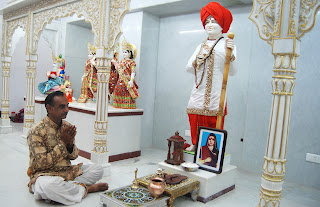COLUMN: Spouse's Turn
Linta
talks about life with her film director-husband Jeethu Joseph
Photo of Linta by Mithun Vinod
By
Shevlin Sebastian
One
day, in 2000, film director Jeethu Joseph and his wife Linta went to
visit a cousin of Jeethu's, Geeta Joy, in Thiruvananthapuram. On a
table in the living room there was a brochure of a film, 'Karunam',
directed by Jayaraj. “When I saw the brochure, I asked Geeta how
she had got it, since she has no links with the film industry,”
says Linta. Geeta told her that they have a house in Thrissur, which
Jayaraj had taken on rent.
Linta
told Geeta that her husband was keen to join films. So, Geeta
arranged for the introductions. “At their initial meeting, Jayaraj
Sir asked whether we had any other means of income and Jeethu said he
had,” says Linta. “That was the only way to survive, since it is
a field where you don't get success immediately.”
Jeethu
began working with Jayaraj as an assistant. At that time, Jayaraj was
working on a Hindi film, 'Beebatsa' which starred Atul Kulkarni and
Seema Biswas. Jeethu also worked on 'Thilakkam', (2003). During this
time, Jeethu wrote his first script, and a producer, Mahe, agreed to
make the film. Called 'Detective', it was released in 2007, with
Suresh Gopi playing a double role. Jeethu also made 'Mummy and Me'
(2010), which did well, as well as the recent hit, 'My Boss'.
Responding
to the charges that 'My Boss' is a lift from the Hollywood movie,
'The Proposal', Linta says, “The initial inspiration may have come
from that film, but it is not a frame-to-frame copy. Jeethu has put
in a lot of effort in the script. The characterisation and the
cultural scenarios are completely different. Basically, you can get
inspired from anywhere.”
Incidentally,
it took some time for Linta to be inspired by Jeethu. In 1994, Jeethu
saw Linta at the St. Sebastian's church in their home town of Elanji,
and was smitten. During Linta's final-year English literature course
at the Dev Matha College in Kuravilangad, Jeethu proposed to her. “I
told him it is an infatuation,” says Linta. “But he said it was
much more than that. Apparently, he had pointed me out to his parents
and sister Mini. I said, 'Let me finish my studies. Please do not
talk or try to speak to me on the phone.'”
But
Jeethu got permission from Linta's parents to talk to her on the
phone. They agreed because Jeethu was the son of VV Joseph, who was
the MLA from Muvattupuzha, and the Josephs were a prominent family of
the area. “Jeethu would talk about films and told me he wanted to
be a director,” says Linta. “I asked whether he could find
another profession, since I knew the risks of a career in the film
industry.”
Anyway,
the couple tied the knot on June 1, 1996. And Jeethu became a
businessman and set up a shopping complex in Elanji. “But as time
went on, I realised that in his heart of hearts he always wanted to
be a director,” she says. And, thankfully, fate played a role in
fulfilling Jeethu's dreams.
As
the couple is basking in the success of 'My Boss', Linta says her
husband consults her frequently, when he is working on a script. “The
moment he gets the thread of an idea, he will tell me,” says Linta.
“When he writes one page of dialogue, he will read out to me. Then
he will ask me how he should move forward. Jeethu is always asking
for suggestions, but it is not necessary that he will follow what I
say.”
In
fact, because she came to know the characters of ‘My Boss’ so
well, Linta helped in selecting the costumes. “Jeethu encouraged me
to be a costume designer,” she says. “For [actress] Mamta's
western-style dresses, I got the trousers, a Diana suit, formal
shirts, and even a swimsuit from the malls in Bangalore. The rest we
got from Ernakulam.”
It
has been an exciting partnership with Jeethu, but there are ups and
down. “He has a lot of positive energy,” she says. “On the
other hand, I have a tendency to look at life in a negative way. His
one drawback is that he gets angry very fast. But within minutes he
cools down and asks for forgiveness. But I find it difficult to
forget what Jeethu tells me when he is angry.”
And
there are practical difficulties also. She has to oversee the
children's education [daughters Catherine, 15, and Katina 11], pay
the household bills, and do all the banking work. Nevertheless, it is
a close and intense partnership, and, as Linta says, with a smile,
“At the end of the day, Jeethu is 'My Boss' and I like that.”
(The New Indian Express, Kochi and Thiruvananthapuram)















